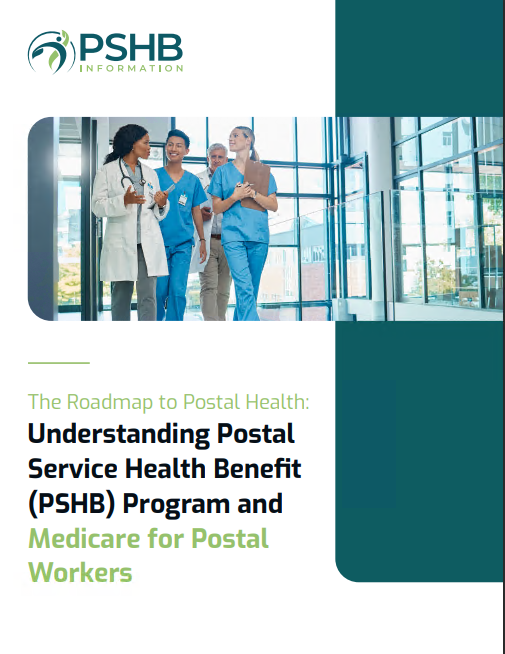Key Takeaways
-
The 2025 health benefits overhaul introduces new requirements and plan structures, making it crucial for USPS employees and retirees to stay informed and prepared.
-
Taking action during Open Season is the best way to ensure you choose a plan that fits your specific healthcare needs.
A Big Change Is Coming for USPS Health Benefits
The Postal Service Health Benefits (PSHB) program is set to replace the Federal Employees Health Benefits (FEHB) program starting in 2025. For USPS employees, retirees, and their families, this marks a significant transformation in how healthcare coverage is offered and managed. Unlike its predecessor, PSHB is tailored exclusively for postal workers, ensuring that the unique needs of employees and retirees are front and center.
This transition brings opportunities to optimize your healthcare options but also demands careful attention to new rules, requirements, and timelines. Without preparation, you could face surprises—whether it’s changes in plan structures, costs, or eligibility rules. It’s essential to familiarize yourself with how PSHB works and its implications for you and your family.
Who Needs to Pay Attention?
The 2025 transition affects everyone within the USPS community who relies on FEHB for health coverage. Knowing how you’re impacted is the first step in navigating this shift successfully:
-
Active USPS Employees: If you’re currently employed, this transition will require you to enroll in a PSHB plan during Open Season to ensure you maintain uninterrupted coverage. This is a mandatory action, so don’t miss it!
-
USPS Retirees: If you’re retired, Medicare integration will become a significant factor in your healthcare decisions. The shift may offer you opportunities for better coverage and reduced costs, but you’ll need to stay proactive to take full advantage.
-
Family Members: Eligible dependents—including spouses and children under 26—will continue to receive coverage under PSHB plans if they qualify. Disabled children over 26 may also remain covered under specific conditions, so check the eligibility rules carefully.
Staying informed about eligibility requirements and plan details is the first step in managing this transition effectively. Missing deadlines or misunderstanding your options could lead to coverage gaps or higher costs.
How Is PSHB Different From FEHB?
The PSHB program is designed specifically with USPS employees and retirees in mind, offering some key differences from the previous FEHB system. These changes make it more aligned with the needs of postal workers, but they also introduce new considerations:
1. Medicare Integration for Retirees
Starting in 2025, most Medicare-eligible retirees and their covered family members must enroll in Medicare Part B to maintain their PSHB coverage. This integration is one of the most significant differences from FEHB. By coordinating benefits with Medicare, PSHB aims to provide comprehensive healthcare coverage while minimizing out-of-pocket expenses for retirees.
The coordination of benefits helps ensure that retirees receive coverage for services that Medicare doesn’t typically handle, creating a seamless package of healthcare support. However, missing the Part B enrollment deadline could result in penalties and gaps in coverage—so it’s vital to plan ahead.
2. Tailored Plan Options
PSHB plans are structured to align with the specific healthcare needs of postal workers and retirees. These plans focus on offering balanced coverage, including preventive care, specialist services, and chronic condition management. Additionally, many PSHB options are expected to prioritize cost efficiency, helping you find plans that fit both your healthcare needs and your budget.
3. Automatic Enrollment for Non-Participants
If you don’t actively select a plan during Open Season, you’ll be automatically enrolled in a default PSHB plan. While this guarantees continuous coverage, it may not be the best option for your needs. Taking time to explore all the available plans during Open Season allows you to select a plan that’s tailored to your specific health requirements and financial situation.
Key Dates You Can’t Miss
Mark your calendar with these critical dates to stay ahead during the transition:
-
Open Season: Running from mid-November to early December each year, Open Season is your golden opportunity to choose or update your health plan. Changes made during this period will take effect on January 1 of the following year.
-
Medicare Enrollment Deadline: If you’re Medicare-eligible, you must enroll in Part B by January 2025 to maintain PSHB coverage. Missing this deadline could mean penalties and gaps in your healthcare.
-
Automatic Enrollment Deadline: Those who don’t select a plan during Open Season will be automatically assigned to a corresponding PSHB plan. While this ensures you’ll have coverage, it’s not guaranteed to be the best fit for your needs.
Staying on top of these dates ensures a smoother transition and prevents unnecessary surprises.
What Will This Mean for Your Costs?
Costs are always a concern when it comes to healthcare, and the PSHB program introduces some important changes that you’ll need to understand:
-
Shared Premium Contributions: USPS will continue to share premium costs with employees and retirees, helping keep plans affordable. This contribution structure mirrors that of FEHB but is tailored to meet the USPS community’s specific needs.
-
Medicare Cost Savings: For retirees, combining PSHB with Medicare significantly reduces out-of-pocket expenses by covering services that Medicare alone doesn’t provide. This can include lower deductibles and reduced coinsurance rates.
-
Out-of-Pocket Caps: One of the most reassuring aspects of PSHB is the annual cap on out-of-pocket expenses. This feature provides financial protection against unexpected healthcare costs, ensuring that major medical events won’t lead to financial strain.
Taking the time to understand the cost structure of each PSHB plan is crucial for budgeting and financial planning. Knowing what your premiums, deductibles, and other expenses will be helps eliminate surprises and keeps you in control.
Preparing for the Transition
The move to PSHB may seem daunting, but with careful preparation, you can make the transition smoothly. Here’s how:
1. Assess Your Current Coverage
Start by evaluating your current FEHB plan. Identify what works well and what could be improved. Are there services you rarely use? Are there areas where you’d like more coverage? Understanding your current plan’s strengths and weaknesses will guide your decision-making and ensure you pick the most suitable PSHB option.
2. Explore Your Options
Take advantage of Open Season to review and compare PSHB plans. Look for plans that:
-
Cover your preferred healthcare providers.
-
Include robust prescription drug benefits.
-
Meet your family’s specific healthcare needs.
-
Offer cost structures that align with your financial goals.
3. Plan for Medicare Enrollment
If you or your dependents are approaching Medicare eligibility, make sure you’re enrolled in Part B before January 2025. Missing this deadline could result in penalties and gaps in coverage, so staying proactive is essential.
4. Stay Informed
The USPS will provide updates and resources to help you understand the new system. Use these tools to make informed decisions, and don’t hesitate to ask questions if anything is unclear.
Why Medicare Matters More Than Ever
For Medicare-eligible retirees, the integration of PSHB with Medicare is a game-changer. Here’s why:
-
Expanded Coverage: Medicare covers many services, but PSHB fills in the gaps, providing a more comprehensive package. Together, they form a seamless system that protects you against high medical costs.
-
Cost Savings: Combining Medicare with PSHB reduces out-of-pocket expenses, including deductibles and coinsurance. This means retirees can enjoy peace of mind without worrying about surprise medical bills.
-
Mandatory Enrollment: Starting in 2025, most Medicare-eligible participants must enroll in Part B to maintain PSHB coverage. Failure to do so could result in coverage gaps or penalties, so planning is key.
Make the Most of Open Season
Open Season is your chance to take control of your healthcare. Use this time to:
-
Reevaluate Your Needs: Changes in your health, family size, or financial circumstances might mean you need a different type of coverage.
-
Explore New Plans: With tailored PSHB plans available, you’re likely to find one that better meets your needs than your current FEHB plan.
-
Secure Comprehensive Coverage: Ensure your chosen plan aligns with your healthcare priorities and financial goals.
Don’t wait until the last minute—use Open Season to make an informed decision.
What Happens If You Don’t Act?
Failing to make a choice during Open Season will result in automatic enrollment in a default PSHB plan. While this ensures you won’t lose coverage, it’s not always the best option. Proactively selecting a plan allows you to:
-
Optimize your benefits.
-
Ensure your plan covers preferred providers and services.
-
Avoid surprises in cost or coverage.
By acting early, you’re in control of your healthcare decisions rather than leaving them to chance.
Long-Term Benefits of the New System
The PSHB overhaul isn’t just about immediate changes. It offers lasting advantages, including:
-
Better Alignment: Plans designed with postal workers’ unique needs in mind.
-
Streamlined Processes: Simplified enrollment and integration with Medicare.
-
Cost Protection: Features like out-of-pocket caps and government contributions help keep healthcare affordable.
What You Can Do Now
Preparing for the PSHB transition requires action. Start by gathering information, assessing your needs, and making a plan for Open Season. Whether you’re an active USPS employee or a retiree, staying proactive ensures you’ll get the most out of this significant change.







